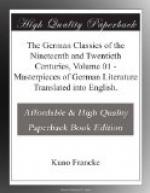In contrast herewith Goethe’s purpose was in his own words, “in an epic crucible to free from its dross the purely human existence of a small German town, and at the same time mirror in a small glass the great movements and changes of the world’s stage.” This purpose he achieved in the writing of Hermann and Dorothea at intervals from September, 1796, through the summer of 1797, in the autumn of which year the poem was published.
The main sources from which the poet drew his material are four. In the first place the theme was invented by him out of an anecdote of the flight of Protestant refugees from the Archbishopric of Salzburg in 1731-1732. On the basis of this anecdote he drew the original outlines of the meeting and union of the lovers. Secondly, as a consequence of the French Revolution, Germans were forced to flee from German territory west of the Rhine. Goethe was present with Prussian troops in France in 1792, and observed the siege of Mainz in 1793. Hence his knowledge of war and exile, with their attendant cruelties and sufferings. Thirdly, the personal experiences of his own life could not but contribute to his description of the then German present. Features of Frankfurt and Ilmenau reappear. The characters show traits of Goethe’s parents, and possibly something of his wife is in Dorothea. Hermann’s mother bears the name of the poet’s and reveals many of her qualities. But some of these are given to the landlord-father, while the elder Goethe’s pedantry and petty weaknesses are shown in the apothecary. The poet’s experiences in the field are realistically reproduced in many particulars of character and incident, as are doubtless also his mother’s vivid reports of events in Frankfurt during July and August, 1796. We may feel sure too that it was the occurrences of this summer that led Goethe to transform the short, pure idyl of his first intention into a longer epic of his own present. The fourth source is literary tradition, which we may trace back through the verse idyl of Voss to the prose idyl of Gessner, thence through the unnatural Arcadian pastorals of the seventeenth and earlier centuries to the great Greek creators,—Theocritus, of the idyl, and Homer, of the epic.
From whatever source derived, the materials were transmuted and combined by Goethe’s genius into a broad, full picture of German life, with characters typical of the truly human and of profound ethical importance, interpreting to the attentive reader the significance of life for the individual, the family, the nation.
HERMANN AND DOROTHEA (1797)[32]
TRANSLATED BY ELLEN FROTHINGHAM
CALLIOPE
FATE AND SYMPATHY
Truly, I never have seen the market and street so
deserted!
How as if it were swept looks the town, or had perished!
Not fifty
Are there, methinks, of all our inhabitants in it
remaining.




